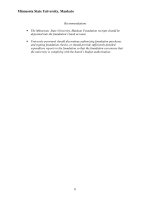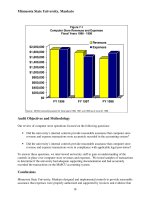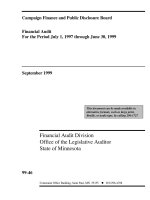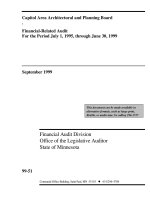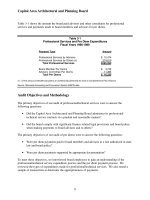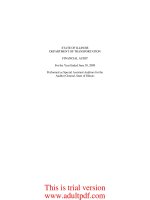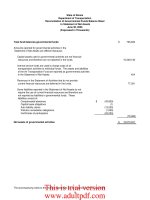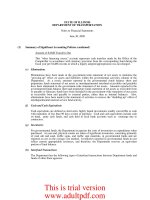Department of Revenue Financial Audit For the Period July 1, 1996, through March 31, 1999 October 1999_part2 ppt
Bạn đang xem bản rút gọn của tài liệu. Xem và tải ngay bản đầy đủ của tài liệu tại đây (36.2 KB, 10 trang )
Department of Revenue
7
Chapter 3. Payroll
Chapter Conclusions
The Department of Revenue designed and implemented internal controls to
provide reasonable assurance that its payroll transactions were adequately
supported, approved, and accurately reported in the state’s accounting records.
In addition, for the items tested, the department processed its payroll
transactions in compliance with material finance-related legal provisions and
applicable bargaining unit agreements.
Employee payroll represents the largest administrative expenditure for the Department of
Revenue. During the “non-tax season” the department employs approximately 1,200 full and
part-time employees. During the period January through April the number of staff increases to
approximately 1,400. The increase is due to the department hiring additional staff to assist in
processing all of the tax returns it receives during this time period.
The Department of Revenue had total payroll costs for fiscal years 1997 and 1998 of
approximately $116 million. Full-time employees accounted for 89 percent of department’s total
payroll expenditures. Table 3-1 shows the department’s payroll summarized by fiscal year and
payroll description.
Table 3-1
Summary of Payroll Expenditures
Fiscal Years 1997 and 1998
Description 1997 1998
Full-time Pay
$51,072,759
$52,465,707
Part-time Pay 4,860,953 5,515,932
Separation Pay
952,168
1,014,191
Overtime Pay
176,533
225,752
Premium Pay 34,346 50,856
Total
$57,096,759
$59,272,438
Source: Minnesota Accounting and Procurement System (MAPS).
Department of Revenue employees belong to various unions that include the following
compensation plans:
• American Federation of State, County, and Municipal Employees (AFSCME)
• Minnesota Association of Professional Employees (MAPE)
• Middle Management Association (MMA)
• Managerial Plan
• Commissioner’s Plan
Department of Revenue
8
Audit Objectives and Methodology
Our review of the department’s payroll transactions focused on the following questions:
• Did the department design and implement internal controls to provide reasonable
assurance that its payroll transactions were adequately supported, approved, and
accurately reported in the state’s accounting records?
• Did the department process its payroll transactions in compliance with material finance-
related legal provisions and applicable bargaining unit agreements?
To answer these questions, we made inquiries of the department’s staff to gain an understanding
of the payroll and personnel process. We tested a sample of payroll transactions to ensure that
there was adequate documentation and authorization for those transactions and also to determine
if controls were implemented. We reviewed overtime and part-time payroll transactions to
ensure the compensation amounts paid to employees were in agreement with employee union
contracts. Finally, we tested the commissioner’s salary to ensure it did not exceed 85 percent of
Conclusions
The Department of Revenue designed and implemented internal controls to provide reasonable
assurance that its payroll transactions were adequately supported, approved, and accurately
reported in the state’s accounting records. In addition, for the items tested, the department
processed its payroll transactions in compliance with material finance-related legal provisions
and applicable bargaining unit agreements.
Department of Revenue
9
Chapter 4. Administrative Expenditures
Chapter Conclusions
The Department of Revenue appropriately authorized and accurately paid and
recorded expenditures for professional/technical services, computer and system
services, rent, and supplies and equipment. The department also properly
executed contracts with outside vendors in accordance with state requirements
and procedures. The department also properly recorded its fixed assets on its
fixed asset system. In addition, for the items tested, the department complied
with applicable finance-related legal provisions.
In addition to payroll, the department's administrative expenditures included payments for
professional/technical services, computer and system services, rent, and supplies and equipment
expenditures.
Contract Services
The department contracts with outside vendors and other state agencies to provide goods and
services to the department. Table 4-1 shows the department’s professional/technical services and
computer and system services expenditures summarized for fiscal years 1997 and 1998.
Table 4-1
Summary of Contract Expenditures
Fiscal Years 1997 and 1998
Description
1997
1998
Professional/Technical Services:
Computer Systems Development
$4,536,116
$4,515,546
General Management and Fiscal Services 1,016,865 978,979
Other
174,418
74,552
Total Professional/Technical Services
$5,727,399
$5,569,077
Computer and System Services:
Production and Maintenance
$2,636,308
$2,702,777
Software Purchase and Rental 257,797 108,457
Total Computer and System Services
$2,894,105
$2,811,234
Source: Minnesota Accounting and Procurement System (MAPS) reports.
The department primarily used contract services for its collections and information system
development divisions. The collections division utilized contracts with collection agencies to
follow up on delinquent accounts. The information system development division supplemented
its staff through the use of contractors or consultants to deliver computer services to the entire
Department of Revenue
10
department. Contract services for the two years ended June 30, 1998, for the collections and
information system development divisions were approximately $1.1 million and $6.4 million,
respectively.
In addition, the department also incurs charges for computer services provided by the
Department of Administration’s Intertechnologies Group (Intertech). The department is charged
for computer processing time on the state’s mainframe computer and telecommunications.
Intertech sends out monthly billings to the department that the information system development
division staff review and approve for payment. The department spent approximately $2 million
per year for Intertech’s services in fiscal years 1997 and 1998.
Rent
The Department of Revenue incurs rental costs for its office space. The department rents office
space throughout the state of Minnesota, as well as in selected other states. In addition to its
main offices in St. Paul, the department also rents office space in such cities as Bloomington,
Brainerd, and Ely. Outside of Minnesota, the department rents office space in major cities such
as Chicago, Dallas, and New York City. For fiscal years 1997 and 1998, the department spent
$7,004,639 and $7,465,620, respectively, to rent office space. In November 1998, the
department relocated to its new building in the capitol complex area. The rent at its prior
location was $560,699 per month compared to $520,693 per month in the new building.
Supplies and Equipment
The department spent $6,238,745 for various supplies and equipment purchases for the two years
ended June 30, 1998. Table 4-2 shows the department’s expenditures for supplies and equipment
summarized by fiscal year.
Table 4-2
Summary of Supplies and Equipment Expenditures
Fiscal Years 1997 and 1998
1997
1998
Supplies:
Supplies, Materials, and Parts $1,321,079 $ 916,785
Other Supplies
3,023
6,559
Total Supplies
$1,324,102
$ 923,343
Equipment:
Computers and Peripherals
$2,158,086
$ 815,820
Other Equipment Purchases 391,181 328,791
Equipment Rental
151,912
145,510
Total Equipment
$2,701,179
$1,290,121
Source: Minnesota Accounting and Procurement System (MAPS) reports.
Department of Revenue
11
Audit Objectives and Methodology
Our review of the department’s administrative expenditures focused on answering the following
questions:
• Did the department appropriately authorize, pay, and record administrative expenditures?
• Did the department appropriately follow state contracting requirements and procedures?
• Did the department record its fixed assets on the state’s fixed asset system?
• Did the department comply with finance-related legal provisions?
To answer these questions, we made inquiries of department staff to gain an understanding of the
controls over the purchasing and disbursement process for services, supplies, and equipment.
We reviewed the department’s bidding process and procedures used for its service contracts. We
performed analytical reviews and tested a sample of contract and professional services, rent, and
supplies and equipment expenditure transactions by tracing to supporting documentation and the
accounting records. Transactions were tested to ensure that the department complied with
finance-related legal provisions.
Conclusions
The Department of Revenue appropriately authorized and accurately paid and recorded
expenditures for professional/technical services, computer and system services, rent, and
supplies and equipment. The department also properly executed contracts with outside vendors
in accordance with state requirements and procedures. The department also properly recorded its
fixed assets on its fixed asset system. In addition, for the items tested, the department complied
with applicable finance-related legal provisions.
Department of Revenue
12
This page intentionally left blank.
Department of Revenue
13
Status of Prior Audit Issues
As of March 31, 1999
The Office of the Legislative Auditor audits annually those Department of Revenue tax programs
that are material to the State of Minnesota’s Comprehensive Annual Financial Report.
Most Recent Audit
Legislative Audit Report 99-4, issued in January 1999, covered the fiscal year ended June 30,
1998. The audit scope included those areas material to the State of Minnesota’s Comprehensive
Annual Financial Report. This report contained one finding, which was a prior audit finding
previously reported to the department. The finding stated that the department did not adequately
verify the integrity of withholding taxes remitted by employers. The finding was first reported to
the department in our fiscal year ended June 30, 1992, Legislative Audit Report 93-31, issued in
June 1993. We will follow up on this finding in our fiscal year 1999 Statewide Audit.
Other Audit History
Legislative Audit Report 98-8, issued in February 1998, covered the fiscal year ended June 30,
1997. The audit scope included those areas material to the State of Minnesota’s Comprehensive
Annual Financial Report. This report contained four findings, one that was a prior audit finding
previously reported to the department. Three of the four findings have been resolved. The one
remaining finding is a prior audit finding and is repeated again in our Legislative Audit Report
99-4, as Finding 1.
State of Minnesota Audit Follow-Up Process
The Department of Finance, on behalf of the Governor, maintains a quarterly process for following up on issues
cited in financial audit reports issued by the Legislative Auditor. The process consists of an exchange of written
correspondence that documents the status of audit findings. The follow-up process continues until Finance is
satisfied that the issues have been resolved. It covers entities headed by gubernatorial appointees, including most
state agencies, boards, commissions, and Minnesota state colleges and universities. It is not applied to audits of the
University of Minnesota, any quasi-state organizations, such as Metropolitan agencies or the State Agricultural
Society, the state constitutional officers, or the judicial branch.
Department of Revenue
14
This page intentionally left blank.
Commissioner's Office St. Paul, Minnesota 55146-7100
October 1, 1999
Mr. James Nobles, Legislative Auditor
Office of the Legislative Auditor
1
st
Floor, Centennial Office Building
658 Cedar Street
St. Paul, MN 55155
Dear Mr. Nobles:
The following are our responses to the findings and recommendations, concerning
the Department of Revenue, that are contained in your audit report for the period
July 1, 1996 through March 31, 1999.
1. The department did not reconcile collections recorded on its computer
system to the corresponding deposits recorded on the Minnesota
Accounting and Procurement System (MAPS).
Recommendation
• The department should reconcile transactions posted to MATS to the
deposits recorded on MAPS.
DOR RESPONSE
Collections recorded in the MCE Account Tracking System (MATS) in fiscal
years 1997 and 1998 were not reconciled to the corresponding deposits
recorded in MAPS. A monthly reconciliation was completed for collections
recorded in fiscal year 1999. In fiscal year 2000, we will continue to
reconcile collections recorded in MATS and MAPS and strengthen the
process by including fees and distributions to clients.
MINNESOTA Department of Revenue
An equal opportunity employer TDD: (651) 297-2196
James Nobles, Legislative Auditor
October 1, 1999
Page 2
2. The department did not properly transfer the collection fees to the
General Fund.
Recommendation
• The department should transfer all collection fees to the General Fund on
a regular basis.
DOR RESPONSE
The collection fees imposed in fiscal years 1997 and 1998 were not transferred
to the General Fund in a timely manner. Fees imposed in fiscal year 1999
were transferred to the General Fund before the MAPS FY99 closing.
Effective beginning fiscal year 2000, fees will be reconciled monthly and
transferred to the General Fund in two installments. The first transfer will be
completed mid-year and the second before the MAPS fiscal year close.
Sincerely,
Matthew G. Smith
Commissioner
Cc: Dennis Erno, Deputy Commissioner
Steve Kraatz, Director, Revenue Accounting Division
Jerry McClure, Director, MCE Division
Jim Maurer, Manager, Office of Internal Audit

